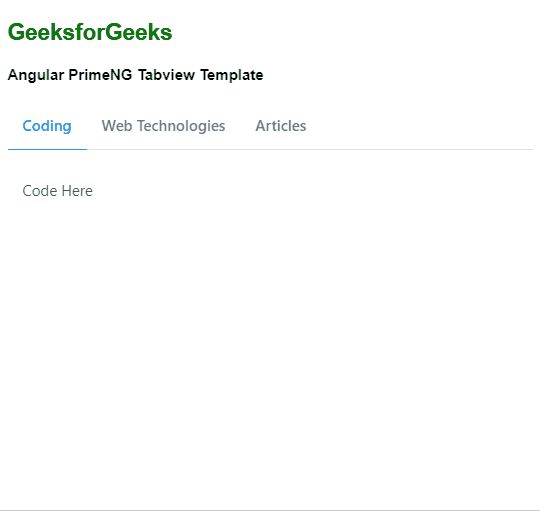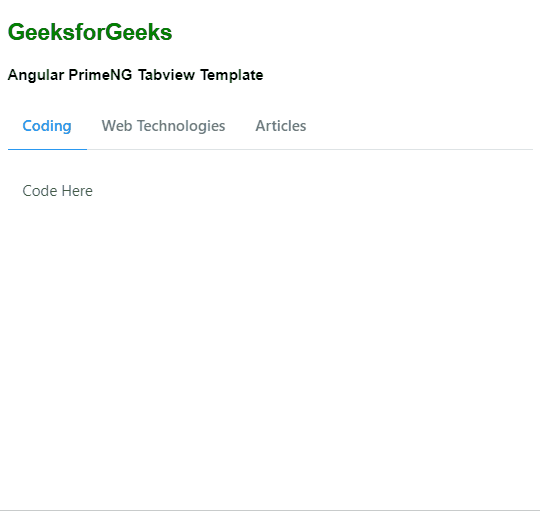Angular PrimeNG TabView模板
Angular PrimeNG是一个开源框架,它有丰富的原生Angular UI组件,可以用来做很好的造型,这个框架用来做响应式网站非常容易。在这篇文章中,我们将看到如何在Angular PrimeNG中使用TabView Templates。
Angular PrimeNG为TabView组件提供了便利,该组件作为一个容器,以将内容与标签分组。TabView模板是用来给TabView组件提供模板的。模板用于设置TabView内容的标题和内容。
语法:
<p-tabPanel header="..">
<ng-template pTemplate="content">
<p>Content</p>
</ng-template>
</p-tabPanel>
创建Angular应用程序和模块安装。
第1步:使用以下命令创建一个Angular应用程序。
ng new appname
第2步:创建你的项目文件夹即appname后,使用以下命令移动到它。
cd appname
第3步在你给定的目录中安装PrimeNG。
npm install primeng --save
npm install primeicons --save
项目结构:它将看起来像如下。
例子1:下面是一个简单的例子,演示Angular PrimeNG TabView模板的使用,我们使用标题模板来给tabview组件提供一个标题。
- app.component.html
<h2 style="color: green">GeeksforGeeks</h2>
<h4>Angular PrimeNG Tabview Template</h4>
<p-tabView>
<p-tabPanel header="Coding">
<p>Code Here</p>
</p-tabPanel>
<p-tabPanel header="Web Technologies">
<p>Learn About Web Technologies</p>
</p-tabPanel>
<p-tabPanel header="Articles">
<p>Read Some Technical Articles</p>
</p-tabPanel>
</p-tabView>
- app.component.ts
import { Component, OnInit } from '@angular/core';
@Component({
selector: 'app-root',
templateUrl: './app.component.html',
providers: [],
})
export class AppComponent {
constructor() { }
ngOnInit() { }
}
- app.module.ts
import { NgModule } from '@angular/core';
import { BrowserModule } from '@angular/platform-browser';
import { RouterModule } from '@angular/router';
import { BrowserAnimationsModule }
from '@angular/platform-browser/animations';
import { AppComponent } from './app.component';
import { TabViewModule } from 'primeng/tabview';
import { ButtonModule } from 'primeng/button';
@NgModule({
imports: [
BrowserModule,
BrowserAnimationsModule,
TabViewModule,
ButtonModule,
RouterModule.forRoot([
{ path: '', component: AppComponent }
])
],
declarations: [AppComponent],
bootstrap: [AppComponent]
})
export class AppModule { }
输出:

例子2:下面是另一个例子,演示Angular PrimeNG TabView模板的使用,我们在这里使用标题和内容,在ng-templates标签的帮助下定义。
- app.component.html
<h2 style="color: green">GeeksforGeeks</h2>
<h4>Angular PrimeNG Tabview Template</h4>
<p-tabView>
<p-tabPanel header="Coding">
<ng-template pTemplate="content">
<p>Code Here</p>
</ng-template>
</p-tabPanel>
<p-tabPanel header="Web Technologies">
<ng-template pTemplate="content">
<p>Learn About Web Technologies</p>
</ng-template>
</p-tabPanel>
<p-tabPanel header="Articles">
<ng-template pTemplate="content">
Read Some Technical Articles
</ng-template>
</p-tabPanel>
</p-tabView>
- app.component.ts
import { Component, OnInit } from '@angular/core';
@Component({
selector: 'app-root',
templateUrl: './app.component.html',
providers: [],
})
export class AppComponent {
constructor() { }
ngOnInit() { }
}
- app.module.ts
import { NgModule } from '@angular/core';
import { BrowserModule } from '@angular/platform-browser';
import { RouterModule } from '@angular/router';
import { BrowserAnimationsModule }
from '@angular/platform-browser/animations';
import { AppComponent } from './app.component';
import { TabViewModule } from 'primeng/tabview';
import { ButtonModule } from 'primeng/button';
@NgModule({
imports: [
BrowserModule,
BrowserAnimationsModule,
TabViewModule,
ButtonModule,
RouterModule.forRoot([
{ path: '', component: AppComponent }
])
],
declarations: [AppComponent],
bootstrap: [AppComponent]
})
export class AppModule { }
输出:

 极客教程
极客教程